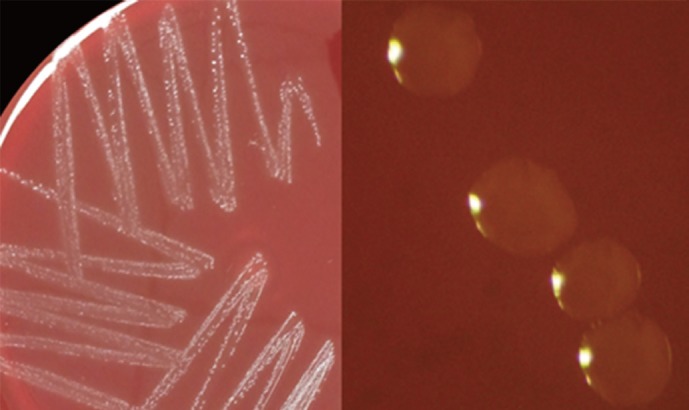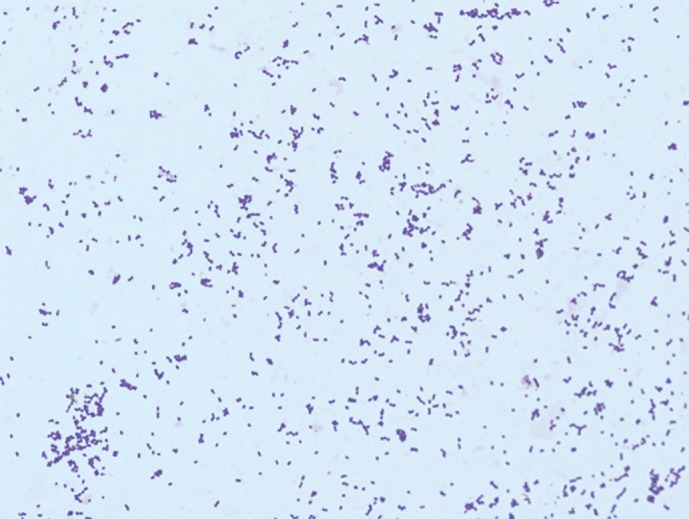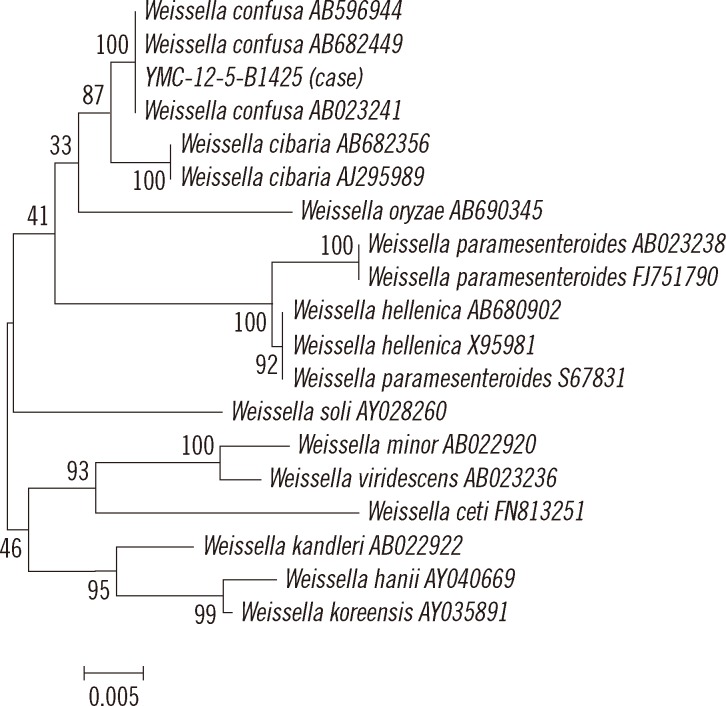Ann Lab Med.
2013 Nov;33(6):459-462. 10.3343/alm.2013.33.6.459.
Weissella confusa Bacteremia in an Immune-Competent Patient with Underlying Intramural Hematomas of the Aorta
- Affiliations
-
- 1Department of Laboratory Medicine, Yonsei University College of Medicine, Seoul, Korea. deyong@yuhs.ac
- 2Research Institute of Bacterial Resistance, Yonsei University College of Medicine, Seoul, Korea.
- 3Cardiology Division, Yonsei Cardiovascular Center and Cardiovascular Research Institute, Yonsei University College of Medicine, Seoul, Korea.
- KMID: 1711322
- DOI: http://doi.org/10.3343/alm.2013.33.6.459
Abstract
- No abstract available.
MeSH Terms
-
Anti-Bacterial Agents/therapeutic use
Aorta/pathology
Bacteremia/*complications/drug therapy/*microbiology
Ceftriaxone/therapeutic use
Female
Gram-Positive Bacterial Infections/*complications/drug therapy/*pathology
Hematoma/*complications
Humans
*Immunocompromised Host
Middle Aged
Phylogeny
RNA, Ribosomal, 16S/analysis
Sequence Analysis, DNA
Spectrometry, Mass, Matrix-Assisted Laser Desorption-Ionization
Tomography, X-Ray Computed
Weissella/classification/genetics/isolation & purification/*physiology
Anti-Bacterial Agents
Ceftriaxone
RNA, Ribosomal, 16S
Figure
Reference
-
1. Ruoff KL. Aerococcus, Abiotrophia, and other aerobic catalase-negative, Gram-positive cocci. In : Versalovic J, editor. Manual of clinical microbiology. 10th ed. Washington, DC: ASM Press;2011. p. 365–376.2. Salimnia H, Alangaden GJ, Bharadwaj R, Painter TM, Chandrasekar PH, Fairfax MR. Weissella confusa: an unexpected cause of vancomycin-resistant gram-positive bacteremia in immunocompromised hosts. Transpl Infect Dis. 2011; 13:294–298. PMID: 21156010.3. Kumar A, Augustine D, Sudhindran S, Kurian AM, Dinesh KR, Karim S, et al. Weissella confusa: a rare cause of vancomycin-resistant Gram-positive bacteraemia. J Med Microbiol. 2011; 60:1539–1541. PMID: 21596906.4. Harlan NP, Kempker RR, Parekh SM, Burd EM, Kuhar DT. Weissella confusa bacteremia in a liver transplant patient with hepatic artery thrombosis. Transpl Infect Dis. 2011; 13:290–293. PMID: 21504525.5. Shin JH, Kim DI, Kim HR, Kim DS, Kook JK, Lee JN. Severe infective endocarditis of native valves caused by Weissella confusa detected incidentally on echocardiography. J Infect. 2007; 54:e149–e151. PMID: 17052757.6. Olano A, Chua J, Schroeder S, Minari A, La Salvia M, Hall G. Weissella confusa (basonym: Lactobacillus confusus) bacteremia: a case report. J Clin Microbiol. 2001; 39:1604–1607. PMID: 11283096.7. Bantar CE, Relloso S, Castell FR, Smayevsky J, Bianchini HM. Abscess caused by vancomycin-resistant Lactobacillus confusus. J Clin Microbiol. 1991; 29:2063–2064. PMID: 1774335.8. Lee MR, Huang YT, Liao CH, Lai CC, Lee PI, Hsueh PR. Bacteraemia caused by Weissella confusa at a university hospital in Taiwan, 1997-2007. Clin Microbiol Infect. 2011; 17:1226–1231. PMID: 21040157.9. Chun J, Lee JH, Jung Y, Kim M, Kim S, Kim BK, et al. EzTaxon: a web-based tool for the identification of prokaryotes based on 16S ribosomal RNA gene sequences. Int J Syst Evol Microbiol. 2007; 57:2259–2261. PMID: 17911292.
Article10. Devulder G, Perrière G, Baty F, Flandrois JP. BIBI, a bioinformatics bacterial identification tool. J Clin Microbiol. 2003; 41:1785–1787. PMID: 12682188.
Article11. Tamura K, Peterson D, Peterson N, Stecher G, Nei M, Kumar S. MEGA5: molecular evolutionary genetics analysis using maximum likelihood, evolutionary distance, and maximum parsimony methods. Mol Biol Evol. 2011; 28:2731–2739. PMID: 21546353.
Article12. Collins MD, Samelis J, Metaxopoulos J, Wallbanks S. Taxonomic studies on some leuconostoc-like organisms from fermented sausages: description of a new genus Weissella for the Leuconostoc paramesenteroides group of species. J Appl Bacteriol. 1993; 75:595–603. PMID: 8294308.13. Park KJ, Park KS, Choi SH, Kim YJ, Ki CS, Kang IS, et al. Haemophilus parainfluenzae infective endocarditis confirmed by 16S rRNA sequence analysis from culture negative tissue. Korean J Clin Microbiol. 2012; 15:139–142.14. Wieser A, Schneider L, Jung J, Schubert S. MALDI-TOF MS in microbiological diagnostics-identification of microorganisms and beyond (mini review). Appl Microbiol Biotechnol. 2012; 93:965–974. PMID: 22198716.
Article15. Bizzini A, Durussel C, Bille J, Greub G, Prod'hom G. Performance of matrix-assisted laser desorption ionization-time of flight mass spectrometry for identification of bacterial strains routinely isolated in a clinical microbiology laboratory. J Clin Microbiol. 2010; 48:1549–1554. PMID: 20220166.
Article16. Barbuddhe SB, Maier T, Schwarz G, Kostrzewa M, Hof H, Domann E, et al. Rapid identification and typing of listeria species by matrix-assisted laser desorption ionization-time of flight mass spectrometry. Appl Environ Microbiol. 2008; 74:5402–5407. PMID: 18606788.17. Mellmann A, Cloud J, Maier T, Keckevoet U, Ramminger I, Iwen P, et al. Evaluation of matrix-assisted laser desorption ionization-time-of-flight mass spectrometry in comparison to 16S rRNA gene sequencing for species identification of nonfermenting bacteria. J Clin Microbiol. 2008; 46:1946–1954. PMID: 18400920.
Article18. Kim M, Kwon MJ, Chung HS, Lee Y, Yong D, Jeong SH, et al. Evaluation of matrix-assisted laser desorption ionization-time of flight mass spectrometry for identification of aerobic bacteria in a clinical microbiology laboratory. Korean J Clin Microbiol. 2012; 15:60–66.
Article19. Björkroth KJ, Schillinger U, Geisen R, Weiss N, Hoste B, Holzapfel WH, et al. Taxonomic study of Weissella confusa and description of Weissella cibaria sp. nov., detected in food and clinical samples. Int J Syst Evol Microbiol. 2002; 52:141–148. PMID: 11837296.
- Full Text Links
- Actions
-
Cited
- CITED
-
- Close
- Share
- Similar articles
-
- Intramural Hematoma of the Ascending Aorta: A case report
- Aortic Intramural Hematoma Associated with Primary Aldosteronism
- Surgical Treatment of Intramural Hematoma of the Aorta: Case Report
- A Case of Bacillus licheniformis Bacteremia Associated with Bronchoscopy
- Spontaneously Developed Pulmonary Arterial Intramural Hematoma That Mimicked Thromboembolism




